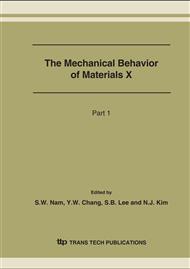p.1337
p.1341
p.1345
p.1349
p.1353
p.1357
p.1361
p.1365
p.1369
Structural Integrity Evaluation of API 5L X65 Pipe Subjected to Pre-Strain up to Tensile Strain Using the API 579 Procedure
Abstract:
Mechanical properties of the pre-strained material are different with those of virgin material without pre-strain. Buried pipelines for natural gas transmission may be deformed by outside force such as ground subsidence, ground liquefaction, cold bending and mechanical damage. Plastic deformation affects the tensile properties and fracture toughness. The effects of prestrain on the mechanical properties of API 5L X65 pipe were diversely investigated through the tensile test, crack tip opening displacement test and Charpy impact test. Axial tensile pre-strain of 1.5, 5 and 10% was applied to plate-type tensile specimens cut from the pipe body prior to mechanical testing. Tensile test revealed that yield strength and tensile strength were increased with increasing tensile pre-strain. However, Fracture toughness for crack initiation decreased with increasing tensile pre-strain. Structural integrity evaluation of the API 5L X65 pipe with crack-like flaws was assessed by using the level 2 in the API 579 code.
Info:
Periodical:
Pages:
1353-1356
Citation:
Online since:
August 2007
Authors:
Price:
Сopyright:
© 2007 Trans Tech Publications Ltd. All Rights Reserved
Share:
Citation:


